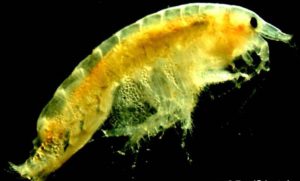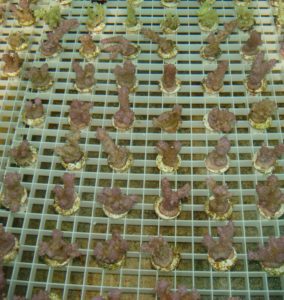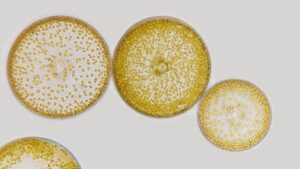Benefits of Pods In Your Reef:
Microcrustaceans (or “pods”) in general, and copepods in particular, are an integral component of aquatic food webs. This is so in virtually every marine environment including coral reef habitats. Therefore, pods in your reef are a healthful addition to any reef aquarium. Lucky, a handful of useful copepod species has become available to reef aquarists for this purpose. Aquaculturists at AlgaeBarn have in fact focused their work on these highly specialized live foods. Consequently, any aquarium hobbyist can acquire a subscription for regularly scheduled deliveries of high-quality live pods. Truly, AlgaeBarn has made it a lot easier for any reef aquarist to sanguinely use the term “pod” as a verb.
This is not a trivial development. It is equally important from an ecological perspective to add pods to your reef than it is to inoculate it with “good” bacteria. An aquarist might add pods in your reef to “seed” it and establish a reproductive population. They might also boost pod populations from time to time by making regular additions (perhaps by subscription). How would you know if you needed more pods in your reef? Are there not many pods visible on the glass and rocks? Is any unwanted film algae or detritus present? Then yes, your tank is ready for a substantial population boost.
[Copepods]
Time for Pods In Your Reef

There is never a bad time to seed your reef with pods. However, the best time to seed is when the nitrogen cycle has stabilized in a newly set up system. At this time, nitrate build-ups have very likely resulted in the growth of undesirable benthic algae. Algal films provide a great food source for copepods that have a benthic adult phase (e.g Tigriopus and Tisbe). These unsightly algal growths will decline as the pod population grows. The pod population size will stabilize after nitrate levels (and thus the algal growth rate) have leveled off. It should only make sense that copepods are best added in the earliest stages of a reef aquarium system set-up; they form the base of the food chain in the natural marine environment.
Certain unfortunate events (death/decay of animals within the tank, accidental over-feedings, etc.) can occur. These disturbances may lead to algal plagues down the road. In such cases, pod additions can mitigate many adverse effects (e.g. detritus build-ups, benthic algal blooms). Typically, there is a sizeable accumulation of detritus and algal biomass in a tank that has running for a while. The pod density might skyrocket when first added to a “dirty” system. Once the offending matter has begun to disappear, the pod population will naturally drop back to its former level. Pod numbers might also drop due to predation. A well-developed system will oftentimes house an abundance and diversity of planktivorous livestock. These creatures will surely welcome any number of pods that you might add. Predation is a great way to lose pods!
Feeding your Copepods
A less than ideal way of losing pods is through starvation. It is quite possible for pods to starve in a reef aquarium. This can happen even if there is a rich source of food growing on or settled out over the tank bottom. Why? Because the vast majority of pods undergo a pelagic stage during their development. Often, this is during the larval development phase. At this stage, larval crustaceans (i.e. nauplii) feed heavily upon microalgae suspended in the water column.
There might be some phytoplankton floating about in the aquarium waters. However, much phyto is trapped in mechanical filters or killed in UV sterilizers. This leaves little phyto for the hungry nauplii. In many cases, it is simply not a sustainable arrangement and the pod population crashes. Copepods are incredibly tough and adaptable. Even so, they are ravenous little creatures and must have access to rich food sources to thrive and multiply.
Die-outs such as these are avoidable with the regular addition of live phytoplankton. Frequent “phyto” supplementation also promotes big, stable populations of highly nutritious pods. It is for this very reason that a premium live phyto product (OceanMagik™) is offered in combination with AlgaeBarn pod subscriptions. What is especially important is that the aquarist adds phyto whenever adding pods to their reef system to control. This is especially so when used for benthic algal blooms. It might seem rather counter-intuitive to add algae to get rid of algae. But one should remember that there must be a suitable density of nutritious phytoplankton present for pods to successfully complete their life cycles.
Let Them Eat Pods
One of the most unique—and indeed desirable—aspects of AlgaeBarn live copepod products is that they include individuals in every life stage. This presents numerous advantages. For example, these mixed-life stage products contain individuals of various sizes. Thus, they are immediately useful as food for filter-feeding animals with a broad range of preferred food particle sizes.
But the primary advantage of adding pods of various life stages becomes apparent just after seeding or boosting a reef tank. Large pods are great for feeding, but if you aim to seed your tank to build a population, you want pods of all ages. Products of this kind promote rapid and steady population booms. As they contain individuals in the earliest stages of development, they are best used alongside a live phyto product.

Since the advent of copepods and phytoplankton by subscription, it has never been easier to add pods to your reef aquarium. An aquarist might seed a reef tank with pods to add to their clean-up crew. A subscription for a mix of benthic copepod species (e.g. Poseidon’s Feast) is ideal for this purpose. This product is also great for use in Fish Only With Live Rock (FOWLR) systems. Aquarists who keep a large number of zooplanktivorous fish or invertebrates may opt for a mix that includes copepods that are planktonic as adults (e.g. 5280 Pods). Both of these products are best utilized in conjunction with live phytoplankton. A subscription to the 5280 Pods & OceanMagik Phyto Combo satisfies these needs efficiently and economically. Now, adding pods to your reef is as simple as pushing a button!
[Copepods]






Hunter T. Villarreal says
I am very new to copepods and was wondering what combination you would recommend. I have a 24 gallon cube and 8 gallon sump that is on week 8 and have added fish and clean up crew. Would 5280 be best due to the diversity of the copepod population to seed my tank? I was also wondering If even the smallest size would be to large for how small my tank is and could having too high of a population be a bad thing?
Thank you for you help,
Hunter
zadok jollie says
Very useful information. Thanks!
Brett says
I love having a pod culture in my sump. It’s a great natural supply of food to the tank
Andrew says
Sweet!
Andrew says
Sweet!!!!
polygonreef says
Very interesting indeed!
Sally says
I have been seeding with varios species of pods from Algae Barn…..love to see the little critters en mass during lights out! Next I need a couple of Mandarins!!!
Jason W Beguhn says
I love that my LFS carries Algae Barn products cause thats how I seeded my tank with pods.
Michael says
Some great info, thank you!
Compy Ginorio says
I see my tank every other month or so. My corals and fishes love to graze in special my wrasse they keep them busy, healthy and happy.
Jeremy says
Pods
Jose says
Thanks for the info
Eduardo Govea says
Thanos for all the excellent products Algeabarn offers.
robert vice says
seeded my tank yesterday
Taylor hahn says
Very informative!
Cole B Presley says
I need more pods for my reef, kinda wants to get a big enough culture for a manderine (however you spell it.)
Cole Presley says
i need to seed my new reef with some pods.
Cole Presley says
woah not sure why it posted my comments 4 different times even though it kept saying comment failed to post haha
roguereef94 says
This great information, a deeper look into the bio organism.
Jered Hedrick says
Just ordered 3 types of pods and chato to add to our tank. Restarting a 93 gallon cube after a cross country move.
With our quick start bacteria and Florida gulf wet rock we’re now looking to plant pods and chato to get out tank solid and stabile running.
Can’t wait for this positive growth and addition to the tank.
Jose Pacheco says
Nice info, thanks algae barn!!!
John key says
Good info! No I know why I don’t see pods in my tank. I think I starved them out. I’ll be needing some new ones and some food for them!
Steven Lombardi says
Anytime I see pods in my tank, I know it is thriving!
artaa1988 says
love seeing pods in my tank
Jessica says
I wish I would have found this article when I first started out. Great information!
sdemarco62 says
New to the pod and learning. Just seeded my tank a week ago thanks to Algar Barn.
Robert says
This information would have been very helpful to me when I first started. 2 years later I met sean and my reef exploded always amazing information thanks guys
Stephen C Frederickson says
I like the total ecosystem approach.
Martin Oldham says
sweet
RICHARD W SMITH JR says
It’s definitely time to pod my reef. Thanks for the order of Macro I got 2 weeks ago. It lit my fuge up beautifully!
And thanks for the treat too
rachel chadwell says
I have noticed faster growth and better coral health and coloration ever since I have added copepods and dose phytoplankton.
Gabriel L Nguyen says
Great article!
Wasabi says
Thanks for all the advice
Ryan mcmillon says
Thata the only thing I can keep alive pretty good with asterinas and hydroids also
Kyle says
Good Wright up very interesting
giddetm says
I love your products and website
Matt Moline says
Hi
Ellen S Imbrie says
Just ordered
Joseph E Bibisi says
Great giveaway!
Brad says
This is great info. Thanks
Rich Knox says
Very cool, this is a great article
snowseifert says
Great info!
Evan says
Woah, great information
Matt Moline says
Thanks
david says
Just got some Tiger Pods from my LFS. They’re fantastic.
david says
Looking forward to the benefits my reef will get.
angelyrojas23 says
Best pods and algae info
Neil Drury says
I have been seeding my tank and refugium with pods for a few months. They are thriving.
Neil Drury says
I have been seeding my tank and refugium with pods for a few months. They are thriving.
Drew says
Awesome!
Jeff B says
My wrasses love pods, the more the better!
Theodore Haider says
Sweet
Mike Polland says
I just received your pods and it doesn’t tell me how to add them???? Am I missing something?
Matheus Petrone says
Thank you for reaching out! You can find an acclimation guide here. If you have any other questions, feel free to call, email, or use the live chat on our website. Have a great day!
Yakov Elizarov says
Your pods are the best. I was able to quickly seed my aquarium
Yakov Elizarov says
Love the products and the jars they come in
Tyler.gore.90 says
This is such an important part of adding to the biodiversity of a reef aquarium and overall success of a tank.
Adam says
Super lit ??
motor795 says
Interesting didn’t know alot
sdemarco62 says
Still new to this but learning a lot. The learn section on the site is packed with info.
Cole Goracke says
If culturing Pods on your own, which would you go with, the 5280? I hear that eventually one species will prevail and overtake the culture, is this true?
wrx777 says
Very cool, i would love to seed my tank with pods and eventually have a mandarin, once the population is healthy and steady.
ReeferReefer says
I find that benthic pods do much better than pelagic pods.
Finn says
Pods for lyf
zadok jollie says
Very useful informantion. Thanks.
Justin says
My tank needs Algae Barn products!
David Hillen says
I have been using Algae Barn products for quite awhile now
Chas Johnson says
I want a prize
WILLIAM WAHL says
The pods/phyto combos from algaebarn are a great way to jumpstart a new tank or even invigorate an established reef!
WILLIAM WAHL says
I love algaebarn!
ecgdc31 says
Great products
chris.singelman says
Great article. I learned a lot.
Steven Semeniuk says
Thanks for all the great info!!
r_nealis says
There is never a bad time to add pods. love these little critters.
zadok jollie says
Useful information. Thanks.
Brian Kaye says
Thanks for the info!
Sean Simkins says
Just gonna go ahead and keep restocking whether I need to or not I guess, can never be too safe with these
Sean Simkins says
Just gonna go ahead and keep restocking whether I need to or not I guess, can never be too safe with these
Douglas putt says
very cool
Doug putt says
sweet!
David says
Should I turn off my UV sterilizer to help my pods grow? If it’s killing their food, that doesn’t seem ideal.
Michael Wahl says
Excellent article on seeding a new reef.
Debbie Bybee says
Great article. I need to add copepods for the corals and fish.
danieoue says
useful information. Thanks!
Scott Chase says
Starting strong is key to keeping a reef see why to many that are sterile anymore with people wondering why they fail to thrive
JW says
Thank you, I was actually wondering if there was a way to do this!!
Becky says
I will be restocking soon!
Becky says
I will be restocking soon!
eric m sear says
sweet dreams
james says
might try to add some when it cools down a bit
Allen says
These kits are awesome
Allen says
Awesome
Allen says
I want this kit
hwarrenfeltz says
cool
hwarrenfeltz says
fun
Allen says
Very informative
Tara Fuller says
Great info!
allison Dale lisney says
4204 Pepper Drive
mamucher says
Great information
Ak Reefer says
Very useful information
Kelly Tompkins says
Do pods naturally make their way to the display tank from the refugium?
Joshua Andersen says
I used all Algae Barn products to seed my refugium and it has taken off and helped to control the nutrients in my tank
CANDICE FONG says
thanks for all the great articles on pods!
Matthew Lucero says
def need to get an order in.
Matthew Lucero says
super job. keep it up
Tim J says
This is such a great way to form the basis of a biodiverse reef tank!
Bobby Daniels says
Great giveaway
Melanie says
Great to seed your tank with pods. Especially if you plan on having a mandarin in your tank.
Stacey Perry says
?
Stacey Perry says
I seeded not only my DT but my fuge as well. Great pods!
Tami says
Going to be following this in the new system!
Alex Lin says
learned a lot !! great post!!
lawrence zapata says
Pods are great for your aquarium. Waiting a little while longer to get a mandarin goby.
Justin says
Thank you!
Tony Holliday says
I seeded my aquarium with live rock.
Karlo says
It’s wintertime here in the east coast and it looks like the copepods I ordered will take about a week to arrive. I have two questions. First, will they even be alive after being transported in freezing conditions? Second, I run two FX6 canister filters in my reef tank. Will they just suck up all the copepods?
Sanele Mbokazi says
Need my coral pod subscription code